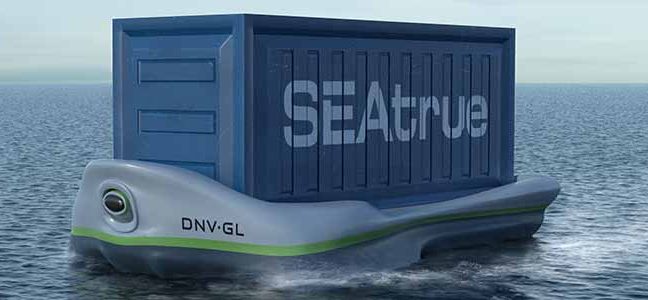A group of Norwegian graduates have spent their summer developing smart “robot containers” with cooling systems that can sail to ports without any human interaction, to held the seafood industry to comply with increasingly strict demands of consumers on sustainable seafood production, DNV GL informed.
Nine graduates have developed SEAtrue, a supply chain for offshore distribution of aquaculture products. The consumer application TraceEat sends information about consumer preferences to the digital platform Veracity, which enables best possible use of resources. The seafood is transported in autonomous smart “robot containers” which employ sophisticated cooling techniques to extend shelf life.
“SEAtrue is a cutting-edge supply chain system that allows for optimal distribution and lower emissions. Moreover, it adjusts production to meet demand and thereby enhance a sustainable aquaculture industry,” says project manager Ole Johan Lønnum, a marine technology graduate at NTNU.
The self-propelled container is released from the processing vessel and either positions itself for pick up by a designated container ship or sails directly to a nearby port. That way, transportation by sea becomes more effective and efficient. Veracity, DNV GL’s proprietary digital platform, uses data from an autonomous fleet of container ships to determine the optimal routing to reach the consumer.
The nine chosen graduates have been assigned the task of finding a solution concerned with overcoming the spiralling costs and sustainability issues currently facing the industry. The solution, which was presented at DNV GL’s headquarter today at Høvik, can revolutionise production and distribution of aquaculture products.
“The summer project paves the way for new and innovative ideas that contribute to fulfill the government’s blue growth strategy, the increasing global shortage on proteins and DNV GL’s vision of making a “global impact for a safe and sustainable future”,” says project manager Liv Aune Hagen at DNV GL.
If the solution is being implemented, this would represent a significant opportunity and progress for Norwegian trade and business.
With the DNV GL solution, additional onshore infrastructure is not a necessity because distribution happens with the use of processing vessels and autonomous self-propelled containers to the market. It entails that the solution is easily scalable from one place to another without special demands for vast infrastructure investments. Thus, the solution is particularly suited for areas with poorly developed infrastructure.
The team emphasises that the solution requires additional small-scale testing. The solution could be implemented by 2030, but this would require opportunistic thinking and strong commitment from all parties involved.






























































